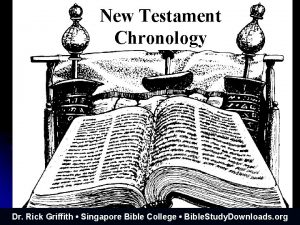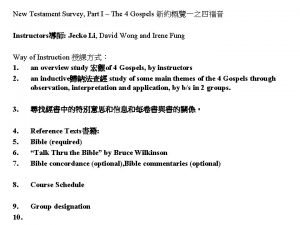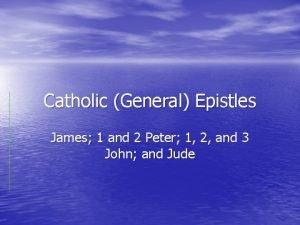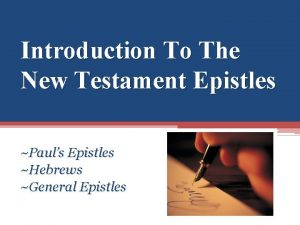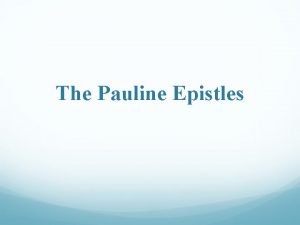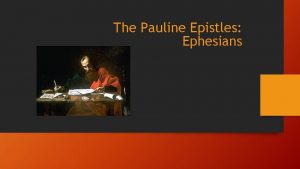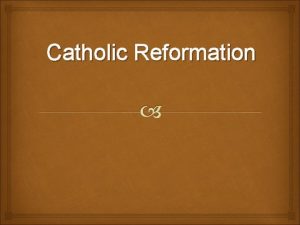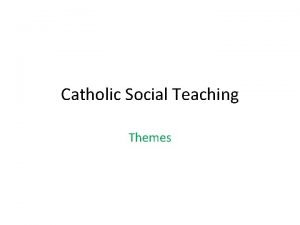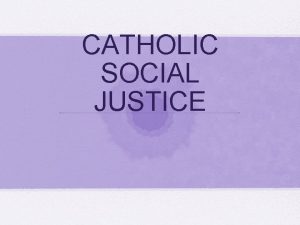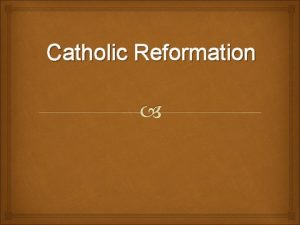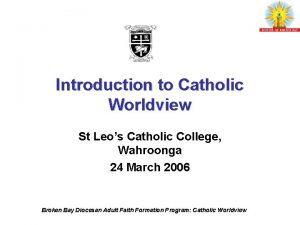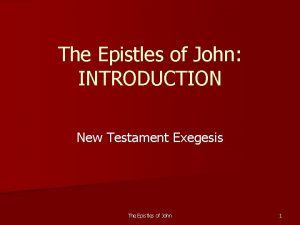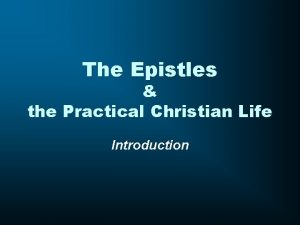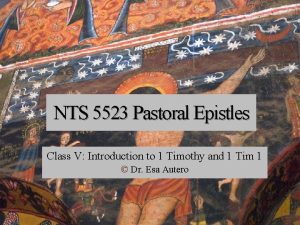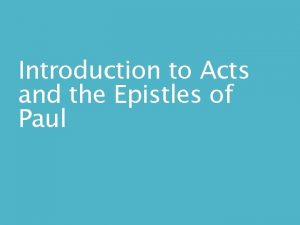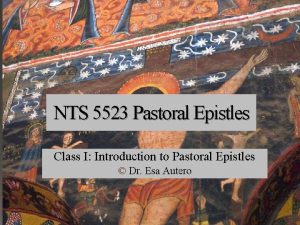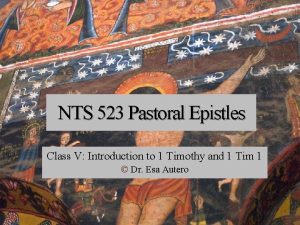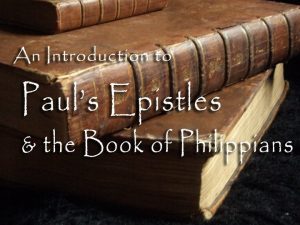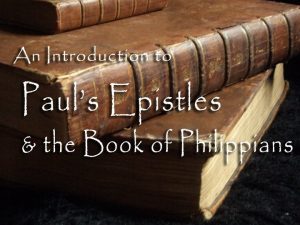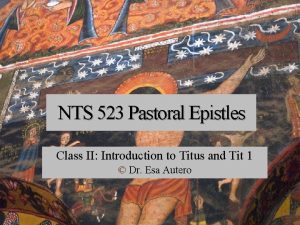The Catholic Epistles Introduction to the Catholic Epistles




















- Slides: 20

The Catholic Epistles

Introduction to the Catholic Epistles

Introduction to the Catholic Epistles What are the Catholic Epistles? + The Catholic Epistles are books in the New Testament in the form of letters. + They are termed ‘Catholic, ’ meaning ‘General, ’ or ‘Universal, ’ because for the most part their intended audience seems to be Christians in general rather than individual persons or congregations as is the case with the Pauline epistles. While the 2 nd and 3 rd epistles of St. John are exceptions, however, due to their smallness, they might be considered as extension to his St. John’s 1 st epistle, especially with them carrying the same nature and style as it does. How Many Catholic Epistles are There? + There are 7 Catholic epistles, which are the epistle of St. James, 1 st…

Introduction to the Catholic Epistles and 2 nd epistles of St. Peter, 3 epistles for St. John and 1 epistle written by St. Jude. The Catholic Epistles and the Church Liturgies: + The Church highly esteems the Catholic epistles, thus reads a part or more of these epistles in most of her liturgical prayers. Characteristic Points About the Catholic Epistles: 1. These epistles are characterized by elaboration in meanings, with brevity in words. 2. Besides their great doctrinal, moral, and inspirational content, the Catholic Epistles are also helpful because of their historical content, where they offer a witness to the beliefs and practices of the first…

Introduction to the Catholic Epistles Christian communities. 3. The writers of these letters were responding to real needs in the early Christian communities, and by examining these problems we can reconstruct the intellectual and spiritual atmosphere that shaped the first generation of the Church. Resemblances In Between the Catholic Epistles: + There are many resemblances in between these epistles, particularly in between: I. The Epistle of St. James and the 1 st Epistle of St. Peter: 1) Enduring Trials and their Significance:

Introduction to the Catholic Epistles a. Joy in the Midst of Tribulations: “My brethren, count it all joy when you fall into various trials, knowing that the testing of your faith produces patience” (James 1: 2) “Beloved, do not think it strange concerning the fiery trial which is to try you, as though some strange thing happened to you; but rejoice to the extent that you partake of Christ’s sufferings, that when His glory is revealed, you may also be glad with exceeding joy” (1 Peter 4: 12 -13) b. The Blessings of Enduring Temptations: “Blessed is the man who endures temptation; for when he has been approved, he will receive the crown of life which the Lord has promised…

Introduction to the Catholic Epistles to those who love Him” (James 1: 12) “In this you greatly rejoice, though now for a little while, if need be, you have been grieved by various trials, that the genuineness of your faith, being much more precious than gold that perishes, though it is tested by fire, may be found to praise, honor, and glory at the revelation of Jesus Christ” (1 Peter 1: 6 -7) 2) Resist the Devil: “Resist the devil and he will flee from you” “Resist him, steadfast in the faith” (James 4: 7) (1 Peter 5: 9)

Introduction to the Catholic Epistles 3) Humble Yourself Before God: “Humble yourselves in the sight of the Lord, and He will lift you up” (James 4: 10) “Therefore humble yourselves under the mighty hand of God, that He may exalt you in due time” (1 Peter 5: 6) II. The 2 nd Epistle of St. Peter and the Epistle of St. Jude: 1) Warning Against False Teachers: “But there were also false prophets among the people, even as there will be false teachers among you, who will secretly bring in destructive heresies, even denying the Lord who bought them, and bring on…

Introduction to the Catholic Epistles themselves swift destruction… for a long time their judgment has not been idle, and their destruction does not slumber” (2 Peter 2: 1, 3) “For certain men have crept in unnoticed, who long ago were marked out for this condemnation, ungodly men, who turn the grace of our God into lewdness and deny the only Lord God and our Lord Jesus Christ” (Jude 1: 4) 2) The Doom of False Teachers: a. The Example of Punishing of the Fallen Angels: “For if God did not spare the angels who sinned, but cast them down to hell and delivered them into chains of darkness, to be reserved for judgment” (2 Peter 2: 4)

Introduction to the Catholic Epistles “And the angels who did not keep their proper domain, but left their own abode, He has reserved in everlasting chains under darkness for the judgment of the great day” (Jude 1: 6) b. The Example of the Burning of Sodom and Gomorrah: “And turning the cities of Sodom and Gomorrah into ashes, condemned them to destruction, making them an example to those who afterward would live ungodly” (2 Peter 2: 6) “As Sodom and Gomorrah, and the cities around them in a similar manner to these, having given themselves over to sexual immorality and gone after strange flesh, are set forth as an example, suffering the vengeance of eternal fire” (Jude 1: 7)

Introduction to the Catholic Epistles 3) The Depravity of False Teachers: a. Reviling Against Authority: “And especially those who walk according to the flesh in the lust of uncleanness and despise authority. They are presumptuous, self-willed. They are not afraid to speak evil of dignitaries. Whereas angels, who are greater in power and might, do not bring a reviling accusation against them before the Lord” (2 Peter 2: 10 -11) “Likewise also these dreamers defile the flesh, reject authority, and speak evil of dignitaries. Yet Michael the archangel, in contending with the devil, when he disputed about the body of Moses, dared not bring against him a reviling accusation, but said: The Lord rebuke you!” (Jude 1: 8 -9)

Introduction to the Catholic Epistles b. Speaking Evil of Things they Do Not Know: “But these, like natural brute beasts made to be caught and destroyed, speak evil of the things they do not understand, and will utterly perish in their own corruption” (2 Peter 2: 12) “But these speak evil of whatever they do not know; and whatever they know naturally, like brute beasts, in these things they corrupt themselves” (Jude 1: 10) c. Reveling in Feasts with Great Pleasure: “They are spots and blemishes, carousing in their own deceptions while they feast with you” (2 Peter 2: 13)

Introduction to the Catholic Epistles “These are spots in your love feasts, while they feast with you without fear, serving only themselves” (Jude 1: 12) d. Following the Way of Balaam for Profit: “They have forsaken the right way and gone astray, following the way of Balaam the son of Beor, who loved the wages of unrighteousness” (2 Peter 2: 15) “Woe to them! For they have gone in the way of Cain, have run greedily in the error of Balaam for profit” (Jude 1: 11) e. Having a Deceiving Appearance:

Introduction to the Catholic Epistles “These are wells without water, clouds carried by a tempest, for whom is reserved the blackness of darkness forever” (2 Peter 2: 17) “They are clouds without water, carried about by the winds… wandering stars for whom is reserved the blackness of darkness forever” (Jude 1: 12, 13) f. Scoffers Walking According to their Own Lusts: “That you may be mindful of the words which were spoken before by the holy prophets, and of the commandment of us, the apostles of the Lord and Savior, knowing this first: that scoffers will come in the last days, walking according to their own lusts, and saying: Where is the promise of His coming? ” (2 Peter 3: 2 -4)

Introduction to the Catholic Epistles “But you, beloved, remember the words which were spoken before by the apostles of our Lord Jesus Christ: how they told you that there would be mockers in the last time who would walk according to their own ungodly lusts” (Jude 1: 17 -18) III. The Three Epistles of St. John: A) Between the 1 st and the 2 nd Epistles: 1. The Imperative of Love: a. Love One Another: “And this is His commandment: that we should believe on the name of His Son Jesus Christ and love one another, as He gave us commandment” (1 John 3: 23)

Introduction to the Catholic Epistles “And now I plead with you, lady, not as though I wrote a new commandment to you, but that which we have had from the beginning: that we love one another” (2 John 1: 5) b. Love is to Keep to God’s Commandments: “For this is the love of God, that we keep His commandments” (1 John 5: 3) “This is love, that we walk according to His commandments” (2 John 1: 6) 2. He Who Denies the Lord Jesus Christ: a. Is an Antichrist:

Introduction to the Catholic Epistles “And every spirit that does not confess that Jesus Christ has come in the flesh is not of God. And this is the spirit of the Antichrist, which you have heard was coming, and is now already in the world” (1 John 4: 3) “For many deceivers have gone out into the world who do not confess Jesus Christ as coming in the flesh. This is a deceiver and an antichrist” (2 John 1: 7) b. Does Not Have God: “Whoever denies the Son does not have the Father either; he who acknowledges the Son has the Father also” (1 John 2: 23) “Whoever transgresses and does not abide in the doctrine of Christ…

Introduction to the Catholic Epistles does not have God. He who abides in the doctrine of Christ has both the Father and the Son” (2 John 1: 9) B) Between the 2 nd and the 3 rd Epistles: 1. The Style of the Opening Greeting: “The Elder, to the elect lady and her children, whom I love in truth” (2 John 1: 1) “The Elder, to the beloved Gaius, whom I love in truth” (3 John 1: 1) 2. St. John’s Children Walking in Truth is a Source of Great Joy to Him:

Introduction to the Catholic Epistles “I rejoiced greatly that I have found some of your children walking in truth” (2 John 1: 4) “For I rejoiced greatly when brethren came and testified of the truth that is in you, just as you walk in the truth. I have no greater joy than to hear that my children walk in truth” (3 John 1: 3 -4) 3. Expressing his Desire to Speak Verbally: “Having many things to write to you, I did not wish to do so with paper and ink; but I hope to come to you and speak face to face, that our joy may be full” (2 John 1: 12)

Introduction to the Catholic Epistles “I had many things to write, but I do not wish to write to you with pen and ink; but I hope to see you shortly, and we shall speak face to face” (3 John 1: 13 -14)
 Chronology of pauline epistles
Chronology of pauline epistles Test: the general epistles new testament survey
Test: the general epistles new testament survey There is no woman's sides
There is no woman's sides Pauline epistles
Pauline epistles Test: the general epistles
Test: the general epistles Hình ảnh bộ gõ cơ thể búng tay
Hình ảnh bộ gõ cơ thể búng tay Slidetodoc
Slidetodoc Bổ thể
Bổ thể Tỉ lệ cơ thể trẻ em
Tỉ lệ cơ thể trẻ em Voi kéo gỗ như thế nào
Voi kéo gỗ như thế nào Tư thế worm breton
Tư thế worm breton Chúa sống lại
Chúa sống lại Môn thể thao bắt đầu bằng từ đua
Môn thể thao bắt đầu bằng từ đua Thế nào là hệ số cao nhất
Thế nào là hệ số cao nhất Các châu lục và đại dương trên thế giới
Các châu lục và đại dương trên thế giới Công của trọng lực
Công của trọng lực Trời xanh đây là của chúng ta thể thơ
Trời xanh đây là của chúng ta thể thơ Mật thư tọa độ 5x5
Mật thư tọa độ 5x5 Phép trừ bù
Phép trừ bù độ dài liên kết
độ dài liên kết Các châu lục và đại dương trên thế giới
Các châu lục và đại dương trên thế giới
